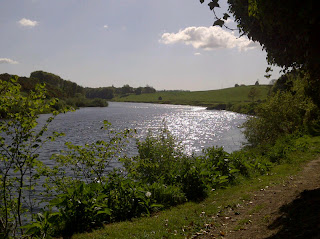This works best with two cars, one left at the Ladykirk Bridge, and the other at the start on a bend of the B6437 just above the Tweed, between Lennel and Whitsome. The path's start is clearly signposted, and part of the Coldstream path network. About and hour or hour and a half, great paths throughout, and very quiet.
Park near the bend noted above, and turn off the road at the signpost marked 'Norham Bridge'.
Follow the path through woods on a steep slope above a bend in the Tweed, which descends slowly to a stone wall.
Pass through a gate into a meadow which descends to the river. Cross the meadow to another fence, and way post. A round fisherman's hut lies ahead.
You are now walking along a grassy flat bank of the river, below a wooded slope. Follow the path as you enter the Milne Graden estate, built by Sir David Milne, second in command at the Bombardment of Algiers. Large North American firs line the bank, and you pass over an ornamental bridge before you see the large Milne Graden House, high above the path up a steep grassy slope.
Continue on along the banks, through a stone arch and into mixed woodland with a good path.
Continue on for a mile or so along a good path with wooden walk ways following the river bank, until you emerge into another sheep meadow with another round fisherman's hut. There is a lot of wildlife on this beautiful, quiet wooded stretch - deer, waterfowl and many butterflies.
Sand Martin's nest in the bluffs above the river on your right. Continue on over a small wooden bridge to another good path along the side of the Upsettlington Estate.There are often fishermen here.
This path is bordered by a formal stone wall with woodland behind - in parts cut smartly into the stone of the river bank. This is a charming and well kept pathway.
The path opens up again to a broad grassy walkway, before turning into another broad meadow.
Follow the sign across the meadow, which has yet another traditional Tweed fishing hut.
Once across the meadow you join another good marked path along the edge of the estate.
Passing another fisherman's hut, and some of the best fishing sites in Berwickshire, you approach the Ladykirk Bridge and the second car.
Ladykirk is worth a look - see my Ladykirk Circuit walk. Across from Ladykirk Bridge is Norham, famous historic border town. It has a great butchers!
Sir Walter Scott described Norham Castle in his poem Marmion as “the most dangerous place in England.”
The Flowers of the Forest
I've heard the lilting, at the yowe-milking,Lasses a-lilting before dawn o' day;
But now they are moaning on ilka green loaning;
"The Flowers of the Forest are a' wede away".
As buchts, in the morning, nae blythe lads are scorning;
The lasses are lonely and dowie and wae.
Nae daffin', nae gabbin', but sighing and sobbing,
Ilk ane lifts her leglen, and hies her away.
In hairst, at the shearing, nae youths now are jeering,
The Bandsters are lyart, and runkled and grey.
At fair or at preaching, nae wooing, nae fleeching,
The Flowers of the Forest are a' wede away.
At e'en, in the gloaming, nae swankies are roaming,
'Bout stacks wi' the lasses at bogle to play.
But ilk ane sits drearie, lamenting her dearie,
The Flowers of the Forest are a' wede away.
Dule and wae for the order sent our lads to the Border;
The English, for ance, by guile wan the day:
The Flowers of the Forest, that foucht aye the foremost,
The prime o' our land are cauld in the clay.
We'll hae nae mair lilting, at the yowe-milking,
Women and bairns are dowie and wae.
Sighing and moaning, on ilka green loaning,
The Flowers of the forest are all wede away.

















No comments:
Post a Comment